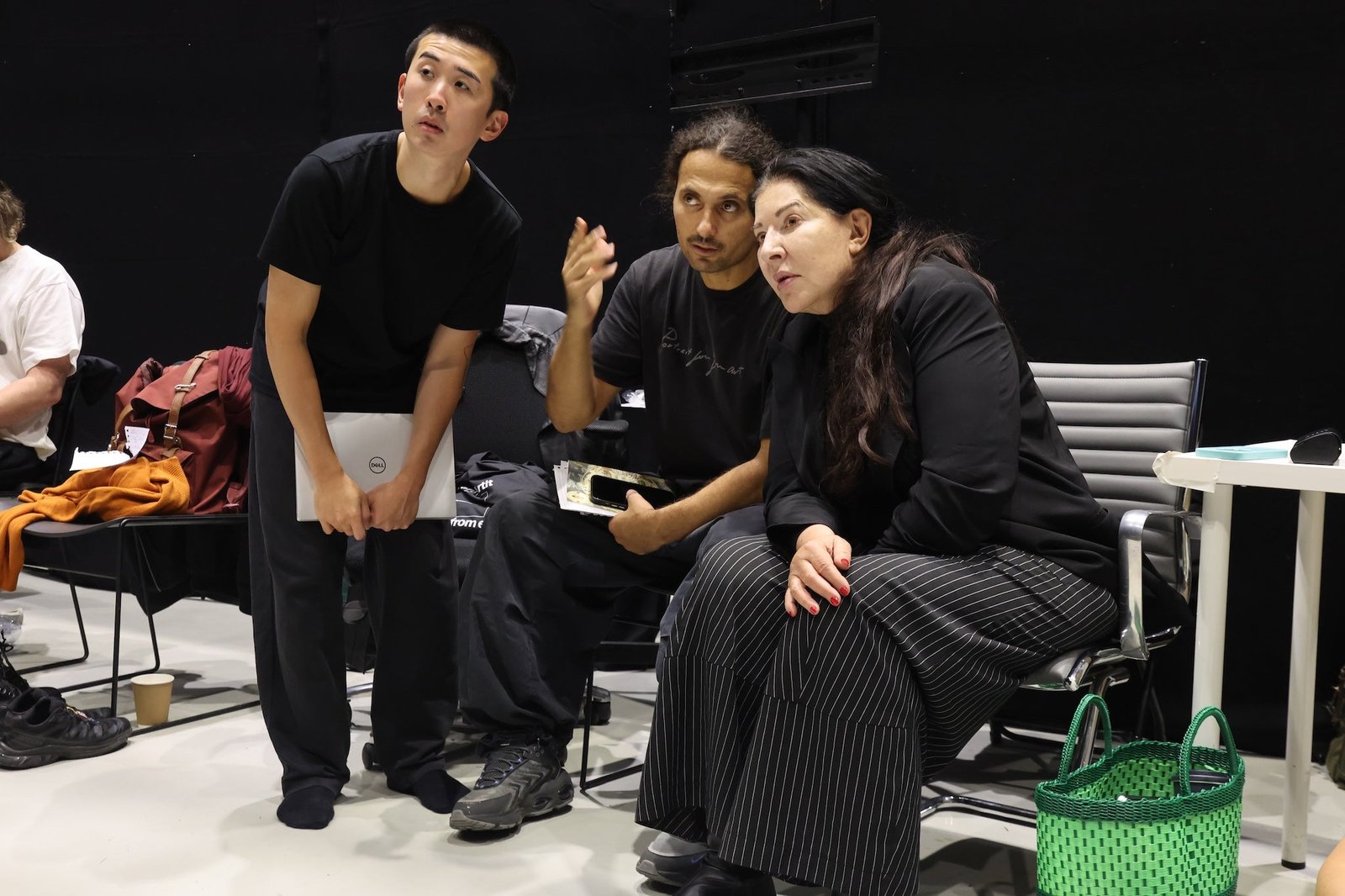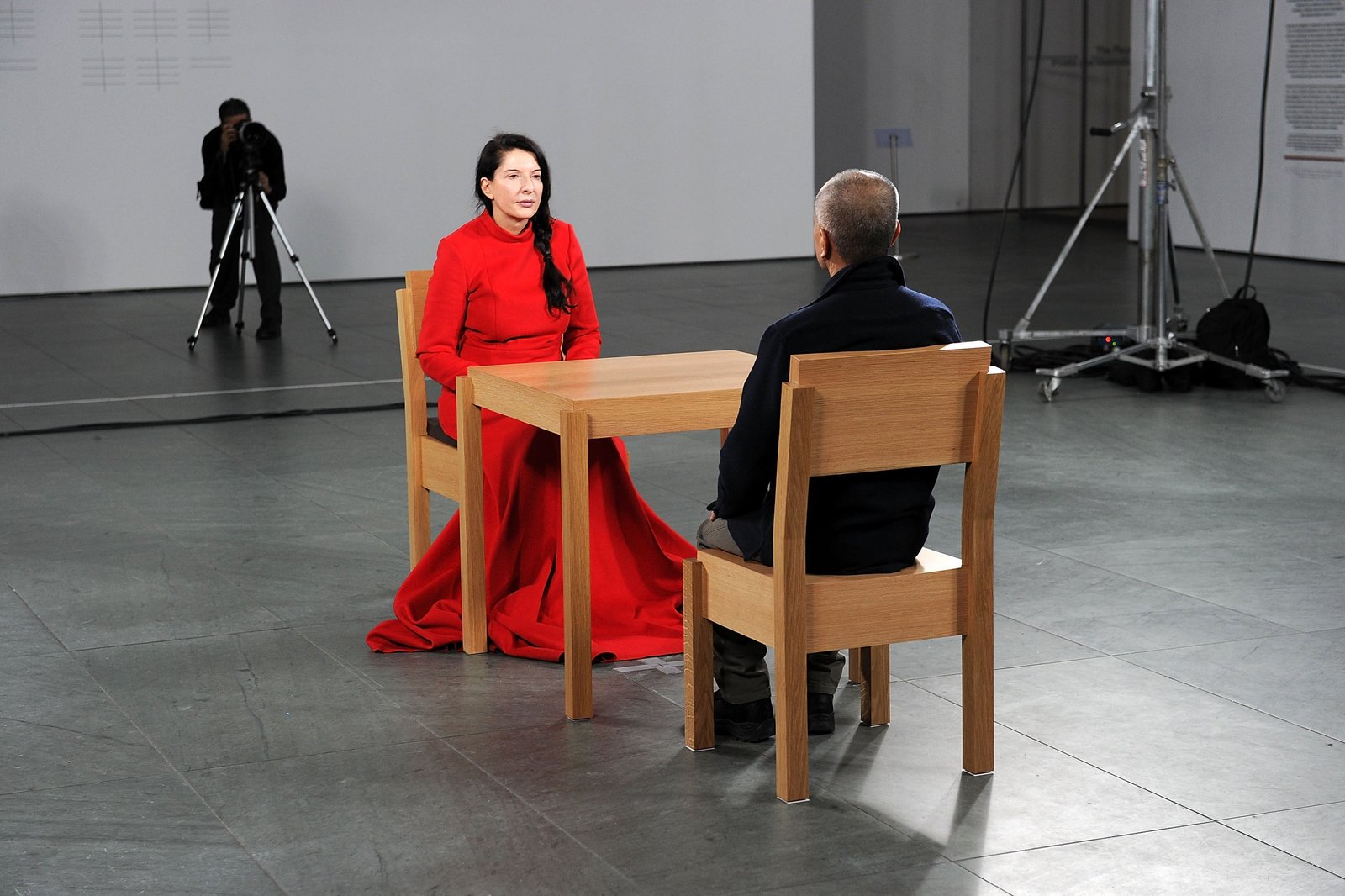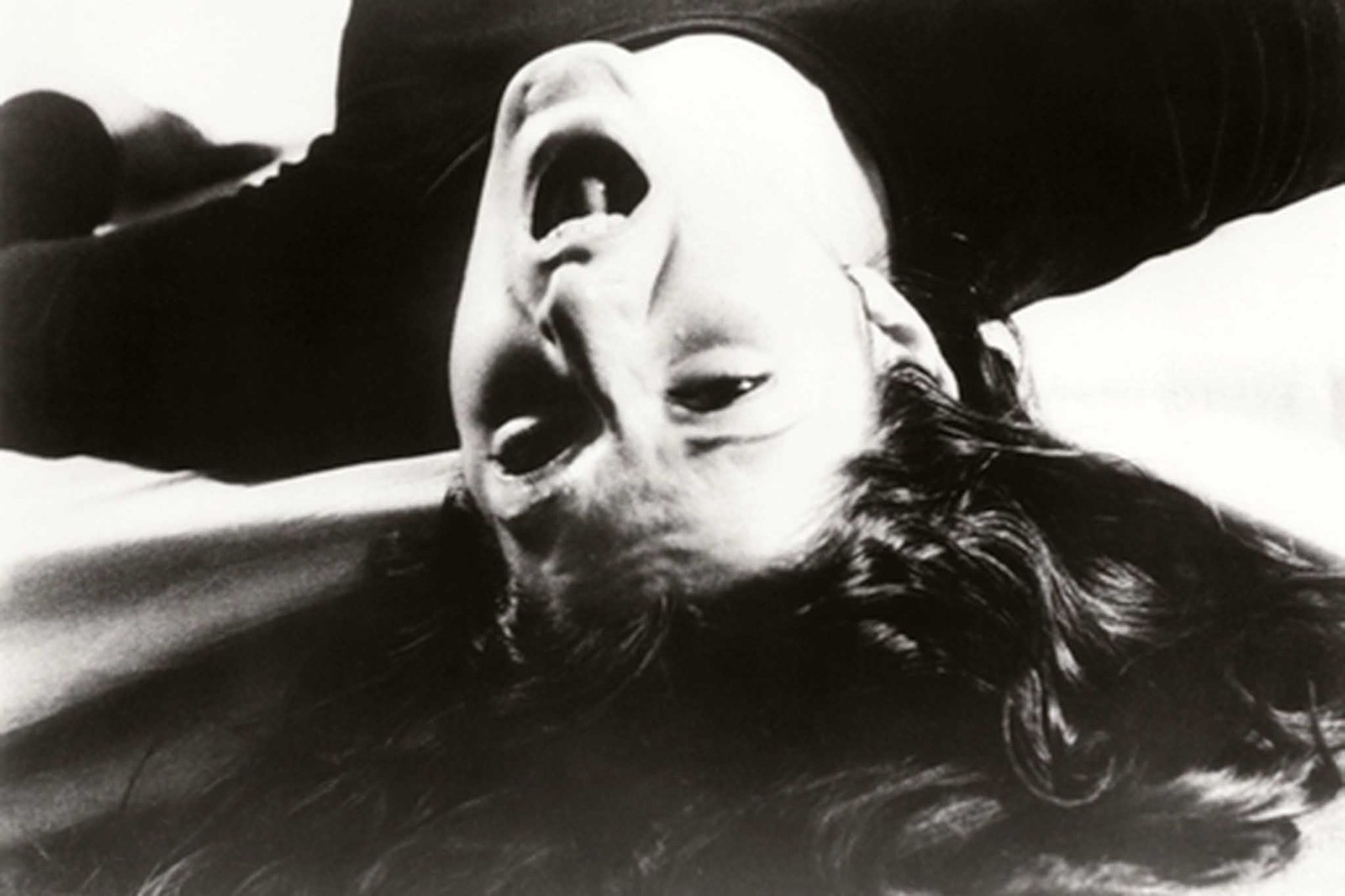When I first meet Marina Abramović, she is busy cajoling a man into modelling an apron. “Please,” she coos. Her entreaties work and he gives in, wrapping the garment’s ties around his waist to show off the front of it, which is covered in rudimentary drawings of penises. Dozens of them. Abramović laughs, taking girlish delight in the phallic doodles, and looks at me: “What do you think?”
I’ve come to Manchester, where Abramović is staging her latest exhibition, overly prepared with pages of questions. At 78, she is a formidable pop culture presence, a pioneering performance artist whose works are considered to be among the most important of the 20th century. But now the first question is lobbed at me, what do I think of this apron of dicks? It’s a turn of events I haven’t prepared for. Although maybe I should’ve.
Abramović has made a career of asking tricky questions. Since the Seventies, her work has pushed the limits of body and mind, as she has sat still in a gallery for months on end, slammed her body repeatedly into a pillar, and laid down inside the blazing frame of a wooden star to the point of asphyxiation. Of herself, she asks, ‘How far can I go? How much can I take?’ So as questions go, the penis apron thing is an easy one to answer: “It’s the perfect Christmas gift!”
It’s part of a range of merchandise sold in promotion of Balkan Erotic Epic, Abramović’s latest and largest-scale performance work, being staged this month in Manchester. “I totally reject the label ‘feminist’ – but this?” She grins a red lipstick smile, holding up a T-shirt that features a bare-chested woman riding a giant phallus like a rocket ship. “This is pretty feminist.”
In Balkan Erotic Epic, more than 70 performers will bring to life the folklore of Abramović’s native Serbia, where sexual rituals were historically used for an array of purposes: to distract enemies on the battlefield; to ease the pain of childbirth; to make a man stay faithful; to encourage a healthy crop yield. Visitors will walk through the colossal space to discover these customs played out. Abramović predicts that us puritanical British are going to have a field day. “I am going to be attacked by every tabloid in this country,” she says gleefully.
The idea was sparked years ago when she was asked to collaborate on a project about how artists react to pornography. “I watched all the pornographic movies, and let me tell you, it’s boring as hell,” she says. “It’s always the same structure. I completely got uninspired.” Instead, she delved into her own culture and its rituals – a window into which she was afforded, as a young girl, by her grandmother, who was more spiritual than her hardline communist parents.
Returning to her roots felt right; next year she’s turning 80. “Once I left Yugoslavia, I went everywhere – living with Aboriginal [people], Tibetan shamans, name it… but I was never really going backwards,” she says. “This is the right age to have the wisdom and distance to do so.”
As much as Balkan Erotic Epic is a cultural reckoning, it is also a personal one. There is an element of wish fulfilment at play as an actor embodying Abramović’s mother walks around the venue, aghast at the vulgarity on show. “My mother is somebody who is an absolute strict communist and really hates sex,” says Abramović, who had a 10pm curfew and lost her virginity late at 24. In the performance, her mother gradually opens up like a flower, until she too strips off. “She completely loses herself, and starts feeling all the desire, and love, and everything else she did not allow herself to feel in life.”

Abramović is every bit as frank as any of her works might suggest, but she’s also funnier and more affectionate. In conversation, she calls me “Baby” in a way that I like. Her voice, thickly accented, is low and quiet, inviting whoever she is speaking to to lean in. Her nails are painted red but are heavily chipped, so that from far away, it looks like they could be bleeding. Her lips, though, are precisely painted, and her hair, jet black, is tied back from her face, which is as pale as the moon.
Along the way, there is some self-congratulation. Abramović points out that her opera project The Seven Deaths of Maria Callas, which premiered in 2020, was a phenomenal success. “First opera of my life, and it is nominated for an Olivier award,” she says. You can hardly begrudge her this; for a long time, she had to pat her own back. “You look at my performances from the 1970s: they’re all in museums now, but the reviews are the worst – they say what I’m doing is ridiculous, and that it is not art.”
The attacks sting. One in particular left its mark. “Your wonderful British press,” she says, sarcastically. Abramović once gave an interview that she thought had gone very well. Excited to see it, she bought a copy of the paper together with a coffee, and sat down for a lovely Saturday morning read: “Then I open it and I want to kill them all!” The title was something like “Marina Abramović loves young lovers, dirty jokes, and magic crystals.” All true, she concedes, “but in that context, you completely diminish 60 years of serious work”. She was left angry, hurt – and expecting the worst from there on out.
.jpeg)
It’s hard to imagine Abramović getting upset over a couple of words. She is a mountain of a woman, immovable. “But artists are sensitive,” she reminds me, “and bad criticism can really make you depressed.” As she has gotten older, Abramović has developed a defence mechanism. “The only thing that matters is that I put every molecule of my being into the work. That’s it. So you can kill me, you can criticise me, you can trash me… but I did my best, and this is what I give to you, and you can do whatever.”
Speaking of loaded guns, how does she – “Oh God, don’t ask me about Rhythm 0!” Abramović squirms. But I must! It is, after all, her most seminal work: in 1974, Abramović sat for six hours in a gallery in Naples and invited an audience to do to her body “as desired” using any of the 72 implements available, which included a rose, a lipstick, matches, paint, a hairbrush, knives, a scalpel, a saw, chains, alcohol, a bullet, and a gun. Abramović was kissed, stripped, posed like a mannequin, hooded, slashed, humiliated. One person showered her with petals from the rose; another thrust its thorns into her stomach. Abramović let it all happen, occasionally crying but never resisting.
At one point, someone held the (loaded) gun to her head. “God, I made this when I was 28,” Abramović says now. “I was 28 and I wanted to die for art. I wanted to show that the public can really kill you.” Her experience of Rhythm 0 fed into The Artist Is Present, which is perhaps her second-best-known work. Part of her 2010 full-scale retrospective at the Museum of Modern Art (MoMA) in New York, it required Abramović to sit in a chair for eight hours a day, every day for three months (on Fridays, she sat for 10 hours). The chair featured a built-in toilet, and her red gown was altered to include a flap for using it.
As with Rhythm 0, members of the public were invited to sit opposite her. But this time, strict rules were enforced by nearby security guards: no touching, no talking, no standing. “After my experience with Rhythm 0, I actually understood the public – and I understand you can’t leave them without any kind of structure,” says Abramović. It’s the reason, she adds, why “I give permission for many artists to re-perform my [other] work, but Rhythm 0 I will never give.”
I was so shocked by this act of pure hate – but I asked the police to let him go
She reached a compromise in respect of The House with the Ocean View, a piece from 2002 in which she’d lived on display in a gallery for 12 days, consuming nothing but water. She insisted the re-performance run for the full 12 days – but agreed that there should be a psychoanalyst and a doctor on hand. “We had to think how somebody in this world of political correctness could do it,” she laughs. “In my time, I never even heard of this stuff!”
Abramović was born in 1946 in Serbia, in what was then Yugoslavia. Her parents were communist war heroes, and her upbringing was strict. “Military”, she calls it. She’s spoken in the past of her volatile relationship with her mother, who used to hit her. Today, she is sentimental about those early hardships. “Looking back now, I learnt discipline – and I am actually very happy, because I see kids now, and nobody has any discipline, and you need that to create something substantial or different.”
Much of her work, especially the Rhythm series in those early years, saw Abramović inflict pain on herself. In 1973’s Rhythm 10, she played “five-finger roulette”, taking a large knife to the space between her fingers, moving faster and faster and cutting herself in the process: rat-tat-tat-tat-tat. “I don’t like pain,” she says, chuckling. “I never do anything painful in my life, I really don’t. But I like to stage painful situations in front of the public. If I go through that process, get rid of the fear, then I can reflect that to the public and they can do that in their life, too.”

When there is no audience, that’s when things get really scary. In 2018, Abramović was attacked in Florence by a man who smashed a painting of her over her head. “Lucky I have a strong head, but I fell to the floor,” she says. “I was so shocked by this act of pure hate, and so, when he was taken away in handcuffs, I demanded to see him. I asked, ‘Why did you do it?’ And he said, ‘You’ll never understand; I have to do this for my art.’ It is just in order to be in every newspaper, which he was – for all the wrong reasons. I was actually so sorry for him, I asked that they let him go.”
Her success – consolidated by The Artist Is Present, which attracted more than half a million people to MoMA – has made a celebrity of Abramović, who once lived hand-to-mouth out of a truck. She has dined with Kim Kardashian (“I’ve done it once, I don’t need to do it again – really”) and held court on the Pyramid Stage at Glastonbury, where she led hundreds of thousands of revellers in a seven-minute silence. Slowly but surely, she has become mainstream: performance artist turned pop star, spoofed on Sex and the City and parodied by Cate Blanchett and Fred Armisen.
The fame might’ve messed with her head (and her art) had it not come well into her sixties. “If I was young, I could have started thinking, ‘Oh my God, I’m really so great’ and got totally f***ed up, started taking drugs, ruined my life and died early – but this came so late in life,” she says. “To make art is not to be rich and famous. To make art is a necessity – it comes from the soul – and I have always done this. So, to me, I never changed. The only change is that I now have visibility, and I have the platform to say something.”
The only difference is I used to live in a car, and now I live in an apartment with a mortgage I have to pay off
Still, money must change things? “Ha ha ha ha, no, Baby,” she says. “It’s so terrible to say this, but it’s not getting better, it’s getting worse.” Her work isn’t selling. “Galleries, collectors, they don’t know what I am selling, because they think that the work is me, but it’s not just me: I’m photographing and making objects that the public can have and experience. But also, female artists are much less paid anyway; my prices are less than any middle-aged male painter.” The only real difference, she says, is that “I used to live in a car, and now I live in an apartment with a mortgage I have to pay off”.
Abramović is great company; energetic. She’s authoritative – “Instagram is not art and it is never going to be. I’m sorry” – and funny: “People my age only come to my shows for two reasons. First, to see if I’m still alive, and second, to see if the work is bad.” She’s also prolific – in part, she believes, because she chose not to have children. “I didn’t want to share my energy,” she says. “If you look historically, every successful woman artist starts having children and the art stops, but not man – man always survives.” Only one person has challenged this perspective: Meryl Streep. “She has four children, and she is a really, really great actress.” Regardless, Abramović sees her students as children. “I have many. I don’t need my own.”

In 2023, Abramović underwent a knee operation, after which she suffered a near-fatal pulmonary embolism that landed her in intensive care for six weeks. It required three operations and nine blood transfusions. She spent some time in a coma. For that year’s big Royal Academy retrospective, she had to travel to London by ship as she was unable to fly.
For someone whose body is so central to her work, ageing must feel like a particular betrayal. “Of course,” she says, but she works with what she’s got. For her opera, Abramović lay in a bed on stage while seven singers performed. “I thought, for this piece, what can I do physically? I can lie in the bed. I can stand up from the bed. I can go to the table. I can break the vase. I can open the window and I can die.”
Figuratively, Abramović has died several times. As for the real thing, it won’t be performance art. “I’ve already done this piece, so now, I just have to really die,” she laughs. Suddenly, as if reminded of mortality’s ticking clock and her unending to-do list, she looks up at me and shoos me away: “OK, I have to go, Baby. I have to work!”
‘Marina Abramović: Balkan Erotic Epic’ is on at Aviva Studios in Manchester from 9 to 19 October, with a talk by Abramović on 11 October; tickets and more information here

